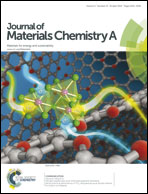A coordination chemistry approach for shape controlled synthesis of indium oxide nanostructures and their photoelectrochemical properties†
Abstract
Indium oxide (In2O3) is an important wide band-gap semiconductor having applications in a variety of optoelectronic devices. We report here on the low temperature solution deposition of In(OH)3 and In(SO4)(OH)·H2O architectures with various shapes such as cubes, maize corns and giant crystals. The In2O3 nanostructures are then obtained by solid state transformation of In(OH)3 and In(SO4)(OH)·H2O architectures. Shape control is achieved by controlling the local concentration of In3+ ions available for reaction by applying the principles of coordination chemistry, thereby obviating the need of any shape controlling agents. The phase and surface composition is obtained by X-ray diffraction (XRD) and X-ray photoelectron spectroscopy (XPS) measurements. The XPS is used to probe the defect structure of In2O3 architecture. Optical properties of the films, studied by UV-Vis absorption and photoluminescence (PL) spectroscopy measurements, show that the different morphologies have different band-gaps. Furthermore current–voltage characteristics of In2O3–CdSe photoelectrochemical cells are studied, which show that cube–CdSe samples display excellent photovoltaic behaviour, exhibiting a short circuit current density in excess of 10 mA cm−2. The charge transport properties of the In2O3–CdSe photoanodes are studied by impedance spectroscopy, which shows that cube–CdSe samples have lowest resistance to charge transfer.


 Please wait while we load your content...
Please wait while we load your content...